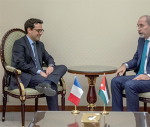You are here
Non-violence in action in Palestine
May 31,2017 - Last updated at May 31,2017
The non-violent movement in Palestine received two extraordinary boosts this week.
After 41 days of abstaining from all foods and drinks, save water and salt, Palestinian prisoners declared victory.
A rigorous 20-hour negotiation process that included the Israeli Prison Services, Palestinian officials and the Red Cross resulted in prisoners gaining most of their demands.
A 21-item declaration, the Ashqelon Agreement was announced by Palestinian support groups detailing the humanitarian demands that the prisoners were able to extract as part of their perseverance and sacrifice.
Nearly 1,600 prisoners were involved in the hunger strike that began on Prisoner Day, April 17 and ended on May 27.
The leader of the hunger strikers, Marwan Barghouthi, who was deeply involved in the negotiations and the decision to suspend the strike, refused to take any food until he was assured by all the prisons that the punishment of the prisoners, including transferring them and putting them in solitary confinement, was rescinded.
The hunger strike was a victory for all 6,000 prisoners, including those who did not join the hunger strike.
Hamas prisoners were among the groups that refrained from joining. Hamas, along with many in the Palestinian leadership, were criticised by the public for not being fully behind the striking prisoners.
Those supporting non-violence as strategically different from the current negotiations-only track of the Palestinian government believe the prisoners’ hunger strike succeeded in galvanising Palestinians everywhere and brought with it plenty of new international support.
The “salt and water” challenge, which was suggested by Barghouthi’s son, Aarab Barghouthi, became an international calling card for those wanting to show their support for the prisoners on hunger strike.
Along with the hunger strike, Palestine witnessed a new non-violence phenomenon.
A coalition of five organisations (Palestinian, Israel and Jewish diaspora) began a campaign to help return Palestinians internally exiled from their homes in the south Hebron area.
The area has been the scene of Israeli army shooting drills, which became the justification for the Israeli army and nearby Jewish settlers to kick out local Palestinians.
The Sumud Freedom Camp, set up by Holy Land Trust, Combatants for Peace, IfNotNow, South Hebron Popular Committee, All That’s Left: Anti-Occupation Collective and the Centre for Jewish Non-violence, was inspired by the Standing Rock protests in the US state of Dakota.
What is unique about the Sumud camp is that nearly 300 Palestinians, Israelis and diaspora Jews put their words into action.
They came to the village of Sarura and set up camp, and helped the villagers resettle.
This was not a onetime act of protest, and the participants were not seeking any provocative confrontations.
It was, and continues to be, a signal of support for the relationship between people and their land.
Even though they did not seek confrontation, the Israeli army raided the impromptu camp three times in the period between May 18 and May 30.
It tore down tents, confiscated sound systems and even a local car, even though the action by the activists is not in violation of any law.
What made the Sumud Freedom Camp different is that for the first time, Israelis and Jews stayed with the Palestinians they were supporting, and rebuilt their camp after every time the Israeli army tried to break it up.
This continuous and unwavering support for the simple act of being steadfast on one’s land is unprecedented.
News about the camp has become a social media success story, with the popular AJ Plus dedicating a video to it and the Internet full of photos and videos of the camp participants and non-violent activism.
The news is also helping organisers crowd fund for current and future activities.
Camp organisers are optimistic that they succeeded in finding a formula that can work in many other places.
This is different in that it is continuous and uses absolutely no violence.
In other protests that take place every Friday, stones are thrown usually at the end of a public rally, the Israeli army represses the demonstrators, photo journalists take their pictures and everyone goes home.
The Palestinian hunger strike and the Sumud Freedom Camp show that Palestinians have little faith in the stalled peace process.
They understand that in order to find a way to end Israeli rule over Palestinians, there has to be a cost to the occupation.
In their own and limited ways, Palestinians, Israelis and Jews are proving that right is might and that a country that depends only on its military power will not win in the long run in a struggle in which people are determined to be free.













